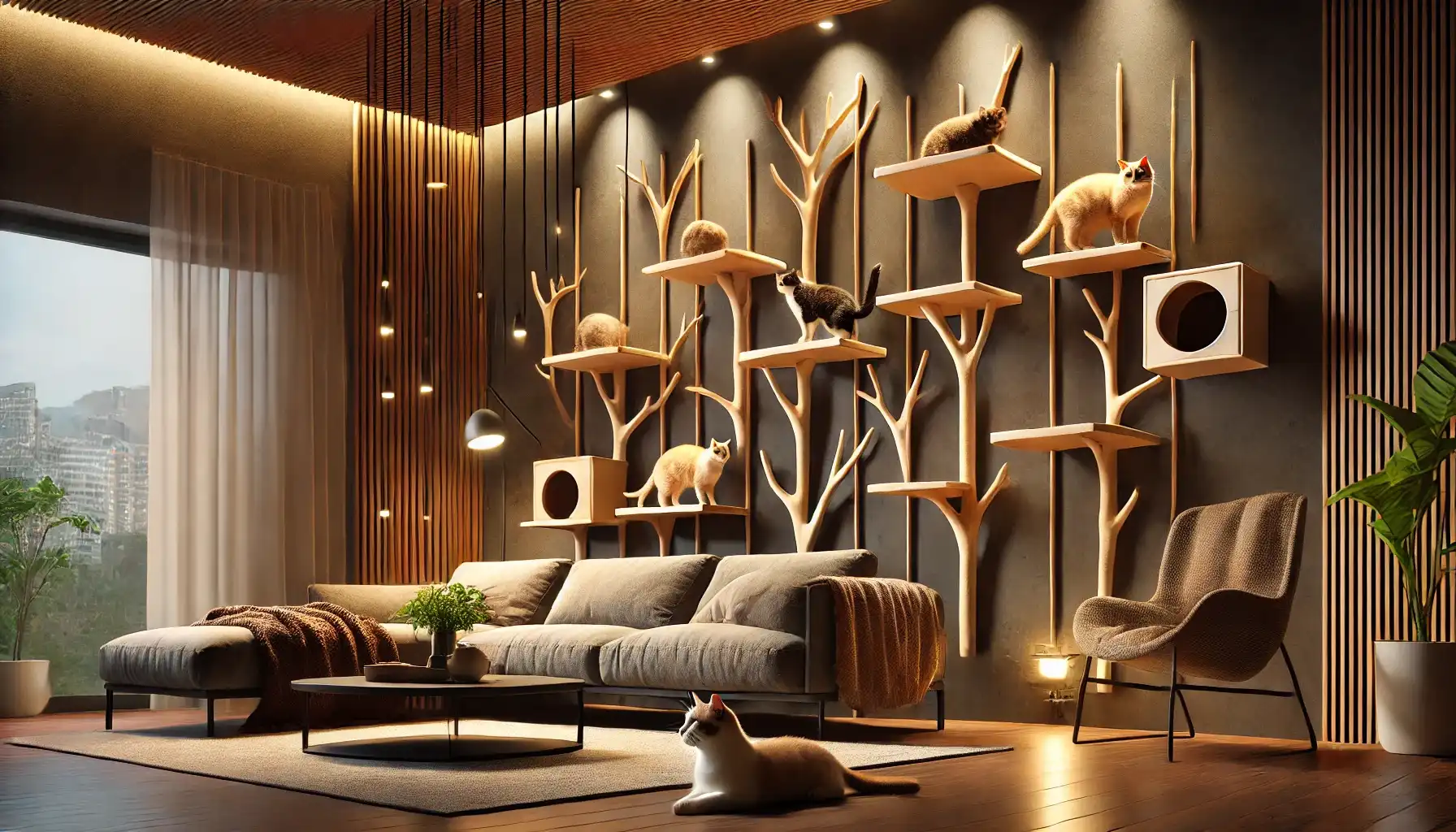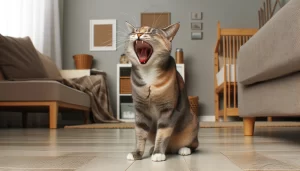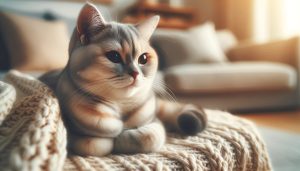In every household, cats are unique and captivating creatures. They are born with a natural instinct to explore and climb, enjoying the safety and expansive view that high places provide. Cats exhibit their natural behaviors by climbing trees and jumping onto rooftops. However, with increasing urbanization and shrinking living spaces, many indoor cats face challenges like limited room and insufficient stimulation, which can lead to anxiety and destructive behaviors. According to a recent study by the American Animal Hospital Association, over 50% of indoor cats exhibit signs of stress due to insufficient environmental enrichment. Therefore, cat shelves, including cat wall shelves, have become essential tools for enhancing the quality of life for indoor cats.
The design of cat shelves is no accident; it has evolved over history to meet the needs of modern homes. From simple wooden planks to today’s diverse designs, cat shelves have become not only a playground for cats but also a decorative element in home aesthetics. This evolution reflects a deeper understanding of cats’ needs and a growing emphasis on enhancing the quality of pets’ lives.
In contemporary homes, cat shelves offer more than just climbing and resting spaces; they help cats better adapt to their environment. By skillfully integrating cat shelves into home design, cats can enjoy more activity space while reducing anxiety and destructive behaviors. This adaptation is not just an extension of physical space; it is also a compassionate approach to the psychological well-being of cats.
By exploring the evolution of cat shelves and their impact on cats’ lives, we will reveal how this seemingly simple structure plays a crucial role in enhancing the quality of life for our feline companions.
Chapter 1
Natural Behaviors and Environmental Needs of Cats
Cats are vibrant creatures, and their instinctive behaviors largely shape their lifestyle and environmental needs. Understanding these natural behaviors not only helps us care for our cats better but also enables us to design living environments that meet their needs.
Climbing and Exploring Instincts
The climbing instinct in cats originates from the survival needs of their wild ancestors, who would scale trees to hunt birds or escape from larger predators. Today, indoor cats exhibit similar behaviors; they might leap onto bookshelves or kitchen counters, seeking high vantage points to observe their environment and feel secure. For modern indoor cats, this instinct remains strong. They often yearn to explore high places, such as perching on cat shelves or claiming a spot on the refrigerator. These elevated positions not only provide a broader view of their surroundings but also instill a sense of security, mimicking their wild ancestors’ behaviors.
Psychological and Physiological Reasons for Height Preference
The preference for height in cats is influenced not only by survival instincts but also by psychological factors. Being elevated provides a sense of control, allowing cats to observe their environment better. Furthermore, height offers a safe refuge, keeping them away from potential threats. Physiologically, cats are built to climb with agility, which not only enhances their hunting prowess but also contributes to their comfort in everyday life.
Impact of Territory Marking and the Need for Security on Cat Behavior
Territory marking is a crucial aspect of cat behavior that involves self-protection and social interaction. Cats use scent to mark their territory, signaling their presence to other cats. This behavior not only helps establish a sense of security but also boosts their confidence in their environment. When cats feel safe, their behavior becomes more positive, and their willingness to play and explore increases.
Environmental Challenges Faced by Indoor Cats and Solutions with Cat Shelves
Although indoor living offers a safe environment, many indoor cats still face challenges such as limited space and lack of stimulation. These issues can lead to boredom, anxiety, and even destructive behavior. To alleviate these problems, cat shelves serve as an ideal solution. By installing cat shelves, cats can climb, rest, and play, satisfying their natural behavioral needs while providing psychological fulfillment.
In summary, understanding the natural behaviors and environmental needs of cats is key to enhancing their quality of life. Cat shelves not only satisfy their climbing and exploring desires but also help them adapt to modern home environments, enriching their overall living experience.
Chapter 2:
Impact of Cat Shelves Design on Behavior
Cat shelves are not just play spaces; they are essential components of a cat’s daily life. Designing the right cat shelves can effectively meet various behavioral needs, allowing cats to enjoy a rich living experience in their home environment. Different types of cat shelves feature unique functionalities and aesthetics, creating an environment that is both fun and secure for cats.
Types and Designs of Cat Shelves
Cat shelves come in various types, ranging from simple wooden planks to intricate multi-level structures. Imagine a lively cat leaping joyfully from one level to another, its paws barely making a sound as it navigates its vertical playground. Some shelves are cleverly designed to resemble trees, inviting cats to climb and explore. Picture a curious cat perched atop a leafy branch, gazing down at its domain, ready to pounce on imaginary prey. These setups not only stimulate their exploratory instincts but also provide a sense of adventure in the comfort of home.
Material Choices and Safety
The choice of materials is crucial for the usage habits and safety of cat shelves. Common materials include wood, synthetic materials, and metal. Wood is not only sturdy and durable but also provides a warm feel, while synthetic materials are easy to clean and wear-resistant. In terms of safety, the structure of cat shelves must be stable to prevent tipping or sliding while in use. Using non-toxic materials is also essential for protecting the health of cats.
Optimizing the Positioning of Cat Shelves
The layout and positioning of cat shelves directly affect the cats’ experience. Arranging cat shelves according to the room’s function and spatial layout can maximize their efficiency. For example, placing shelves near windows allows cats to enjoy sunlight and outside views, enhancing their activity space and observation pleasure. Moreover, the height and spacing of the shelves should consider the cat’s jumping ability to ensure they can climb and leap safely.
With thoughtful design and layout, cat shelves can significantly enhance the quality of life for cats, meeting their behavioral needs. Integrating cat shelves into daily life not only brings joy to cats but also creates a harmonious atmosphere for their owners.
Chapter 3:
How Cat Shelves Improve Behavioral Issues
The behavior of cats is often influenced by their environment. When they feel bored or anxious at home, they may engage in destructive behaviors, such as scratching the sofa or knocking things over. By providing appropriate cat shelves, owners can not only satisfy their cats’ climbing instincts but also create an engaging and safe environment, significantly improving their behavior.
Benefits of Climbing, Resting, and Physical Activity
Cat shelves provide essential climbing and resting spaces that meet cats’ instinctual needs, while also promoting physical activity. Climbing high gives cats a sense of safety and allows them to survey their surroundings. Regular movement on cat shelves helps cats build muscle strength and flexibility, which contributes to their overall cardiovascular health. This active lifestyle not only helps reduce anxiety and destructive behaviors caused by boredom but also keeps cats happier and healthier overall.
The Role of Environmental Enrichment
Environmental enrichment is about enhancing a cat’s life through diverse stimuli and activity spaces. For example, when Sarah adopted a shy tabby named Leo, she quickly realized that he needed more than just food and shelter. She decided to install cat wall shelves in her living room, creating a mini jungle for Leo. Almost immediately, she noticed a transformation. Leo, who once hid under the sofa, began to explore his new shelves, climbing to new heights and batting at toys. This not only kept him active but also brought joy to both Leo and Sarah, illustrating the profound impact of environmental enrichment.
Successful Application Examples
In several animal shelters, the use of cat shelves has greatly improved the behavior of cats. Many shelters have implemented cat shelf systems that offer multi-level activity spaces, allowing cats to climb and explore freely. This not only reduces conflicts among cats but also enhances their overall well-being. These success stories highlight the significant impact of cat shelves on improving cat behavior.
In summary, cat shelves provide essential activity spaces for cats and play a significant role in improving behavioral issues, promoting mental health, and enhancing physical well-being. By designing and installing cat shelves thoughtfully, pet owners can effectively elevate the quality of life for their feline companions.
Chapter 4:
Cat Shelves and Cat’s Environmental Adaptability
Cats are sensitive creatures, and their reactions to changes in their environment can significantly impact their behavior and emotions. In new settings, such as during a move or changes in family members, cats may feel anxious or unsettled. This is where cat shelves can play a crucial role in helping cats adapt to their new surroundings.
The Role of Cat Shelves in Feline Adaptation and Harmony
When cats are moved to a new home, their sense of familiarity is disrupted, leading to disorientation and anxiety. For example, when Emma moved to a new apartment with her cat Max, he initially hid under the bed, feeling overwhelmed. To help Max adjust, Emma installed cat shelves along the walls, providing him with elevated spaces to observe and explore. These shelves not only gave Max a sense of security but also created personal territories for him, which is crucial in multi-cat households. In multi-cat households, territorial awareness can lead to conflicts. Emma noticed that after installing the shelves, Max became more confident, which helped reduce his initial anxiety. Similarly, other families have reported that by providing individual climbing spaces, they’ve seen a decrease in fighting among their cats. For instance, by varying the heights and styles of the shelves, each cat can claim its own space, minimizing territorial disputes.
By placing cat shelves near windows or elevated spots, cats can observe the outside world, helping them regain a sense of control over their new environment. These shelves encourage cats to explore their new home actively, allowing them to move around in high places, which boosts their confidence and helps them adjust gradually. Moreover, the diverse design of cat shelves caters to the individual needs of each cat, providing them with safe spaces to retreat from one another, thereby minimizing potential conflicts.
Considerations for Designing Cat Shelves for Elderly and Special Needs Cats
When designing cat shelves, special attention must be paid to elderly cats and those with special needs. As cats age, their climbing abilities may diminish, so this should be considered in the design of cat shelves. Opting for lower shelves ensures that cats can easily access them, while the structure should be stable to prevent accidental falls.
Additionally, incorporating resting areas with cushions for these cats can provide extra comfort. This design not only meets their needs but also ensures they feel safe and content while using the cat shelves.
In summary, cat shelves play a vital role in helping cats adapt to new environments, reducing conflicts in multi-cat households, and meeting the special needs of elderly cats. By thoughtfully designing and positioning cat shelves, pet owners can significantly enhance their cats’ quality of life and create a more harmonious home environment.
Chapter 5:
Practical Case Studies of Cat Shelves
When creating a comfortable living environment for cats, practical case studies of cat shelves provide valuable insights and experiences. By observing and analyzing these examples, we can better understand the effectiveness of cat shelves and their impact on the quality of life for cats.
Examples of Cat Shelves in Different Home Environments
In many homes, I’ve noticed my fellow feline friends enjoying their new cat shelves. For instance, in a spacious living room, one lucky cat found a wonderful setup of multiple levels to explore. These shelves became my favorite playground, offering me perfect spots to climb, rest, and survey my kingdom from above. I could leap from one shelf to another, feeling the thrill of the chase as I spotted a bird outside the window. This design not only keeps us entertained but also allows us to enjoy playtime in a safe environment.
Some families opt to combine cat shelves with window sills, creating a perfect “cat observation station.” On sunny days, cats can bask in the sunlight on the shelves while watching birds and trees outside, satisfying their curiosity. This design not only enriches the cats’ living experience but also makes them feel joyful and relaxed.
Optimizing Living Spaces for Cats in Small Homes or Apartments
In small homes or apartments, space is often limited, but this doesn’t mean cats can’t have a rich living environment. Cat shelves can make full use of vertical space, providing cats with more activity areas. By installing shelves on the walls, owners can effectively free up floor space while giving cats a higher range of movement.
For instance, many apartment owners in cities design cat shelf systems on their walls, allowing cats to enjoy climbing and resting even in limited spaces. This design enables cats to engage in diverse activities within small apartments while creating a tidy living environment for their owners.
Analyzing the Impact of Cat Shelves on Behavioral Issues
Cat shelves not only enrich cats’ lives but also effectively address common behavioral issues such as aggression and anxiety. Studies show that cats with ample activity space are less likely to exhibit anxious behaviors. When cats can freely climb and play on cat shelves, their stress levels significantly decrease, thereby reducing instances of aggression.
In several successful cases, owners have found that by adding cat shelves, fighting behavior among cats has significantly decreased. Cat shelves provide individual spaces for cats, allowing them to find safe havens for themselves, thus reducing opportunities for conflict. This positive change not only improves cat behavior but also enhances family harmony.
User Feedback and Effectiveness Assessments
Many pet owners provide positive feedback about the use of cat shelves, noting that their cats become more active and happier after installation. User feedback indicates a noticeable increase in exploratory behavior and social interactions among cats, while anxiety and destructive behaviors decrease. This feedback not only validates the effectiveness of cat shelves but also offers valuable insights for other cat owners.
By compiling these cases and feedback, we can see that cat shelves are not just a part of cats’ lives but an essential tool for enhancing their quality of life. Thoughtful design and application of cat shelves can help cats achieve a better living experience at home.
Chapter 6:
Choosing the Right Cat Shelves
Choosing the right cat shelves for your feline friend is a crucial step in enhancing their quality of life. Cat shelves are not only activity spaces but also places for relaxation and rest. With the right selection, cat shelves can create a safe, comfortable, and stimulating environment for cats.
Decision Framework: Choosing Cat Shelves Based on Your Cat’s Needs
Steps to Choose Cat Shelves:
1. Know Your Cat’s Age: Young cats need higher, more complex shelves to satisfy their energy. Consider choosing shelves that are at least two levels high for jumping opportunities.
2. Assess Health Status: Elderly cats or those with special needs benefit from lower shelves with cushioning for safe access. Opt for shelves that are no higher than 24 inches to ensure safety.
3. Consider Personality: Some cats prefer solitude; others enjoy interaction. Choose shelves that suit their behavior. Observe your cat’s daily habits to determine their preferences.
Home Design Styles and Cat Shelf Selection
The style of home design directly influences the choice and layout of cat shelves. Modern and minimalist homes are best suited for cat shelves with clean lines and coordinated colors, creating a harmonious look with the overall decor. In contrast, traditional-style homes may benefit from wooden cat shelves, adding a touch of nature and warmth.
When choosing cat shelves, consider their placement as well. Shelves should be located in well-lit areas or near windows, allowing cats to enjoy sunlight and external views. This arrangement not only makes cats feel comfortable but also enhances the appeal of the home environment.
Budget and Cost-Effectiveness Analysis
Choosing the right cat shelves also requires a budget and cost-effectiveness analysis. There are various types of cat shelves on the market, with significant price differences. When setting a budget, it is crucial to consider the durability and safety of the shelves. Inexpensive cat shelves may have quality issues, while higher-quality shelves, though pricier, provide a safer experience for cats.
Additionally, consider purchasing second-hand cat shelves or diy cat shelves, which can save costs while creating a unique activity space for cats. By carefully managing the budget, pet owners can ensure they select cat shelves that are both economical and functional.
In conclusion, choosing the right cat shelves is a vital step in enhancing a cat’s quality of life. By understanding the needs of their cats, considering home design styles, and conducting reasonable budget analyses, pet owners can create a safe, comfortable, and enjoyable living environment for their feline companions.
Throughout this article, we have explored the crucial role that cat shelves play in improving cat behavior and enhancing their environmental adaptability. Cat shelves not only provide climbing and resting spaces for cats but also effectively satisfy their instinctual needs for exploration and security. As modern living environments change, the challenges faced by cats become more pronounced, and cat shelves emerge as effective tools to address these challenges.
We have seen how appropriately designed cat shelves can significantly reduce anxiety and destructive behaviors in cats. By creating enriched environments, cat shelves help cats stay active and promote their mental well-being. Numerous successful case studies confirm this, with many pet owners noticing their cats becoming happier and healthier after installing cat shelves.
In conclusion, it is crucial to provide a suitable living environment for cats. Whether through selecting the right cat shelves or considering home design styles, owners must pay attention to their cats’ needs. Cat shelves are not just structures; they represent the quality of life for cats and symbolize the owner’s care for their pets. By creating a safe, comfortable, and stimulating environment with the help of cat shelves, owners lay a solid foundation for their feline friends’ happy lives. With cat shelves, we not only provide a space for cats to play and rest but also open a new window for their health and happiness.
Appendix
Detailed Guide for the Maintenance and Cleaning of Cat Shelves
Maintaining the cleanliness and good condition of cat shelves is crucial for the health and safety of cats. Here are some simple maintenance and cleaning tips:
Regular Inspections
Check the cat shelves at least once a month to ensure that all connection parts are secure and that there are no loose or damaged areas. If you find any issues, repair or replace them promptly.
Surface Cleaning
Use mild soap and water with a soft cloth to regularly clean the cat shelves, removing dirt and cat hair. Avoid using harsh chemical cleaners that could harm your cat’s health.
Keep It Dry
Ensure that the cat shelves are thoroughly dried after cleaning to prevent mold and bacteria growth. You can place the shelves in sunlight for a while to naturally disinfect them.
Regular Material Replacement
If there are worn pads or other accessories on the cat shelves, replace them promptly to maintain comfort and safety. Regularly check the materials of the cat shelves to ensure they are not damaged.
Recommended Resources and Reading Materials
To further explore the selection, design, and use of cat shelves, the following resources and reading materials offer valuable information:
“Cat Behavior and Training”
This book delves into the natural behaviors of cats and provides practical insights for choosing the right cat shelves.
Online Communities and Forums
Joining communities like “Cat Lovers Forum” allows you to interact with other cat owners and share experiences and design ideas for cat shelves.
Manufacturer Websites
Visiting reputable cat shelf manufacturers’ websites can provide information on different types and styles of cat shelves, along with user reviews and recommendations to help make informed choices.
Studies in Animal Behavior
Referencing studies in animal behavior can provide insights into how environmental design can improve the quality of life for cats and enhance their adaptability.
By regularly maintaining the cat shelves and utilizing these resources, you can ensure that your cat’s activity space remains safe, comfortable, and stimulating, thus enhancing their quality of life.




